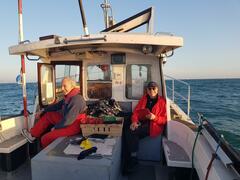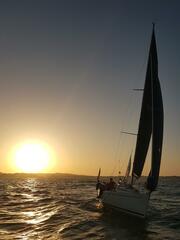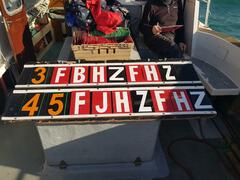The decision to transfer Sundays mornings cruisers race to Saturday afternoon because of Remembrance Sunday meant a busy race programme, with dinghies programmed to have two races alongside Squibs, IRC class 3,4 and 5 also competing out on the water.
Team Rumrunner could not muster a full crew to compete, so we decided to volunteer for race duties with Stuart on the RIB, Phil Gray as ARO and myself as RO and Viking driver. we were ably assisted by John Tonks the Safety boat driver and Roger Horlor as ARO.
Leading up to Saturday, concern had been expressed about the dinghies having to mix it with the cruisers in what could be a congested start line for their second start with all sorts of permutations thought out to ensure everybody had a great, safe day out on the water.
Saturday the 12th dawned bright and dry with a breeze from the South East.
With the race team mustered at 12.15 and after consulting with class captains and Rear Commodore sailing, Mike Street, we set out into a very lumpy Weymouth bay anchoring North West of mark 'J'
With the knowledge that mark 'F' was missing the RIB was dispatched to lay a temporary mark in its position and get a wind reading.
With it flicking between 120/130 'H' was the obvious downwind mark, giving a one mile beat. A smaller half mile course was set within for the Squibs and dinghies with 'J' as the gybe mark.
The IRC 3's would have 'B' as theirs with the 4/5's utilising 'J'.
All good so far and the Dinghies were dispatched at 13.35. The Squibs first signal was 14.00, with IRC cruisers following after, so we had time for a breather to take numbers and photos of the course boards in case there were any queries afterwards.
Not long into the first beat, the RIB radio'd up to say that they were dealing with a capsize so we would have to keep eyes out of Viking to ensure the safety of the other dinghies.
With the clock (which was playing up and fading every now and then) making its way up to the hour, Richard Woof on Jo 90 queried if 'B' was in position, with no RIB to check as it was still engaged with the upturned dinghy, we quickly changed 'B' for 'K' and advised the fleet by VHF.
By now, the Hornet was approaching the line for a second time but was struggling to get over said line due to what we thought was a massive wind shift. I looked through the cabin windows and there in the distance dead ahead was a laid mark, so no wind shift.
Phil Gray then said, look at the laid leeward mark, I turned round and realised that with 28 metres of chain out we had still dragged .1 of a mile.
Up with the AP, on with the engine and up with the anchor. We motored upwind a fair way above the pin, whilst the rest of the dinghy fleet tried to catch us up!
Laying nearly 40 metres of chain out we settled down and with the pin on a bearing of 035' it was an almost perfectly square line.
Then, Simon from Betty calls up and informs us that 'K' is missing, so another course change for the IRC 3s as 'C' becomes their gybe mark and this is transmitted out to the fleet, along with instructions that 'F' was replaced with a mark and that the dinghies were racing so keep out of their way.
Meanwhile the RIB was still trying to right the stricken dinghy.
With a delay of 9 minutes the AP was dropped and a minute later the timing sequence was restarted.
Without further ado the three starts went off without any incidents.
By now the dinghies were coming round for their 45 minute recommended race duration so up with the 'S' and with 'F' below to finish them as they came around.
Normally the dinghies (as they race average lap) like to do a triangle for their first race and a sausage for the second. However, after consulting with them, they preferred another triangle but on a bigger course.
We duly obliged.
However, spanner in the works. The RIB was not on station as it was towing the errant dingy back to the safety of the harbour, so no safety cover meant no racing for the dinghies until it had returned.
With the RIB having confirmed it would be back on station within five minutes we started the race sequence for the dinghy fleet whilst still taking bearings on the pin to ensure that we were not heading for Preston Beach road.
As the starting horn sounded from the automatic sequencer the RIB motored around the back of Viking to confirm its presence back on station.
The rest of the race went like clockwork and as the last of the cruisers appeared out of the sinking sun for the finish line, a feeling of relief settled over us.
Safely back alongside, we put Viking to bed, shook hands and went upstairs to the clubroom to compile the results and re-hydrate.
A thoroughly testing duty in fairly lively conditions where just standing up was sometimes an issue, let alone the trials of missing marks, dragging anchors, busy start lines and a distracted RIB.
The overriding thoughts of the day upon reflection, was that everything worked. The crane to put the RIB in, the RIB was fuelled and fully kitted out.
Viking started on the button, it too was fuelled and equipped with everything that a race team would want.
But this doesn't happen by accident, a team of members, behind the scenes ensure that this happens, not just for this particular Saturday afternoon, but for every event the club puts on.
Its warming to be a member of a club that enjoys a great position on the harbourside, with fantastic facilities, some of the best sailing waters in the country and as someone reminded me last evening, good beer at the bar.
Oh! and lets not forget Amanda in the galley.
Submitted on 13th November 2022



